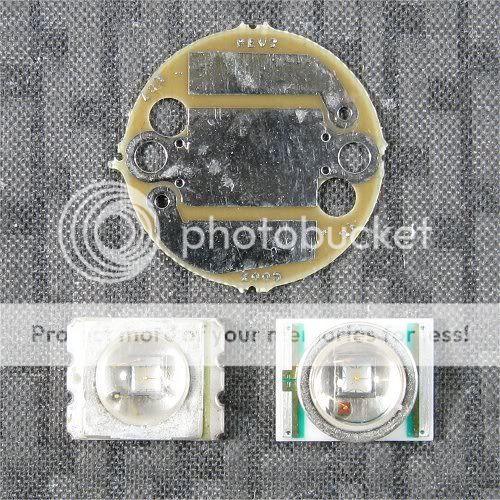DaFABRICATA
Flashlight Enthusiast
I put a Cree UV in my Surefire E1B and tried a McE2S 2-stage switch just for the heck of it. I know the light has a 2-stage driver so I figured it would just flicker like it did when I tried it before the mod. I noticed if I just barely made contact, I could get this TINY die to light up RED!!!
I've seen this in the Osram golden dragon (I THINK:thinking: )in maybe the RA lights?? I'm not sure...memory sucks.:tinfoil:
Anyway, I was wondering what it is, and if there is a specific current I can give the LED to light just the RED die continuosly. I can see when the UV comes ON the RED die goes OFF..:candle: It will turn on with the UV part for a split second and then goes off, but the UV stays lit. I have been able to have the red only light up when tapped just right.
Also would this hurt the LED??
I can't get it to light constantly, but was able to get a crappy pic of what it is doing. I had to tap the side of the light while the timer on the camera helped get the shot.
It certainly looks cool!!
Anyone know whats up with this??



EDIT: Heres some better shots I was able to get.:thumbsup:
RED & UV



I've seen this in the Osram golden dragon (I THINK:thinking: )in maybe the RA lights?? I'm not sure...memory sucks.:tinfoil:
Anyway, I was wondering what it is, and if there is a specific current I can give the LED to light just the RED die continuosly. I can see when the UV comes ON the RED die goes OFF..:candle: It will turn on with the UV part for a split second and then goes off, but the UV stays lit. I have been able to have the red only light up when tapped just right.
Also would this hurt the LED??
I can't get it to light constantly, but was able to get a crappy pic of what it is doing. I had to tap the side of the light while the timer on the camera helped get the shot.
It certainly looks cool!!
Anyone know whats up with this??




EDIT: Heres some better shots I was able to get.:thumbsup:
RED & UV



Last edited:









